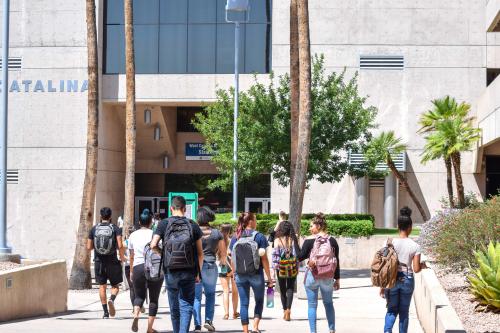The Biden administration recently released their budget proposal for FY 2025. Even though the president has a limited role in setting the Department of Education’s (ED) budget, the budget proposal is one of the most powerful tools the president has in the budget process, as it sets an early agenda for negotiation and subsequent congressional debates.
This year, President Biden released his budget proposal prior to the current fiscal year being fully funded. The final FY 2024 Department of Education budget—signed into law on March 9, 2024 after over five months of continuing resolutions—totaled about $79.1 billion, slightly less than its FY 2023 budget. The FY 2025 Department of Education discretionary budget requested is $82.4 billion. As illustrated in Figure 1, this is lower than the requested FY 2024, 2023, and 2022 budgets, though higher than the enacted FY 2024, 2023, and 2022 budgets. Of note, the FY 2024 and FY 2025 budgets are restricted by funding caps set for nondefense discretionary programs in the Fiscal Responsibility Act of 2023 (FRA) that raised the debt ceiling.
The FY 2025 budget also comes during an election year. President Biden’s proposal serves not only as a roadmap for budget negotiations but a chance to outline his priorities for a second term, showing how he would advance many of the initiatives outlined in his 2024 State of the Union.
President Biden often invokes his father’s aphorism “show me your budget, and I’ll tell you what you value” when discussing federal fiscal policy. Below, Brookings scholars reflect on the Department of Education’s FY 2025 budget proposal to see what we can learn about what the administration values. Scholars also share insights about the underlying policy problems that the funding proposal attempts to address and what research shows about how effective these proposals might be at advancing students’ well-being.
The President has previously proposed to “double Pell,” increasing the annual maximum Pell grant award to $13,000 a year by 2029. The Pell Grant (developed by late Brookings scholar Lois Rice in collaboration with Senator Claiborne Pell) is a need-based, undergraduate financial aid program. About 40% of undergraduates receive a Pell Grant—6.1 million students in 2021-22. Almost half of Pell recipients have a family income less than $20,000. The revised Free Application for Federal Student Aid (FAFSA) formula launched this year should increase both the number of students eligible to receive any Pell and the share of students eligible for the maximum award.
The maximum student award was $7,395 for the 2023-24 school year and was held flat in the FY 2024 budget. The president proposed increasing maximum Pell to $8,145 for the 2025-26 school year (a $750 or 10% increase). This FY 2025 proposal is actually lower than what the administration requested in FY 2024 when they proposed an $8,215 maximum award for the 2024-25 school year. This smaller increase may reflect growing concerns about the fiscal sustainability of the Pell program and would require even larger increases in subsequent years for “double Pell” to become a reality by 2029.
Notably, the FY 2025 proposal differentiates the maximum award based on the institution a student attends, setting a lower maximum award ($7,495) for students enrolled in proprietary (for-profit) institutions. For-profit colleges leave students, on average, worse off than public or private nonprofit institutions, with lower earnings and higher student loan debt. Amid concerns of a rise in for-profit enrollment post-pandemic, it seems the goal of differentiating Pell amounts would be to sway prospective students toward enrolling in nonprofit institutions where their award would have more “purchasing power.” ED often applies different federal financial aid eligibility rules for for-profit and nonprofit institutions. For example, the “90/10 rule” states proprietary institutions (but not nonprofit institutions) must receive at least 10% of their revenue from non-federal funds. Similarly, under the latest “gainful employment” regulations only for-profit colleges or non-degree programs in any sector would lose aid eligibility if they failed debt-to-earnings thresholds. I applaud the effort to steer students to enroll in nonprofit institutions that on average leave students better off. Still, I worry what precedent it sets for future presidents to propose limits on the Pell grant based on the colleges a student attends.
The Pell Grant is the crown jewel of the federal higher education system—it opens the doors to postsecondary education for millions of students a year who otherwise would not be able to afford college. Pell is the foundation upon which additional college access and success initiatives are built and in the FY 2025 budget and beyond should be preserved and increased to fulfill our nation’s commitment to higher education and social mobility.
Rachel M. Perera
One of the most important roles that the federal government plays in education is protecting students’ civil rights. While a federal right to a high-quality education does not exist, students are entitled to an education free from discrimination based on race, ethnicity, and shared ancestry, gender and sexual identity, disability status, and age. And it’s the responsibility of the Department’s Office for Civil Rights (OCR) to enforce those protections in more than 13,000 school districts and 5,700 postsecondary institutions across the country.
Educational civil rights are the baseline standards students should expect to encounter in any institution under OCR’s jurisdiction. Yet, for decades, OCR has not been adequately funded to ensure those baseline standards are met. Making matters worse, OCR’s caseload has exploded in recent years. In FY 2023 alone, OCR received more than 19,000 civil rights complaints from students and advocates across the country alleging a wide range of civil rights abuses. This is a dramatic increase from the early 2000s when OCR’s caseload averaged 5,000. Yet, OCR has fewer FTE staff now (562 in 2023) than they had in 2003 (672). The consequence of this imbalance is a civil rights enforcement agency that is far more reactive than proactive and investigations that can take years to resolve.
The president’s proposed budget includes an increase of $22.4 million to OCR’s budget—bringing the agency’s FY 2025 budget to $162.4 million. This 16% budget increase will largely be used to increase staffing levels at OCR by 86 FTE. This increase is notable, and I applaud the Biden administration for recognizing the important work OCR does—and that they need more resources to do that work well. But a 16% increase is not enough. This is especially true as OCR takes on an increasingly wide range of pressing contemporary discrimination issues. In the last six months alone, OCR has opened more than 60 new investigations into complaints of antisemitic, anti-Muslim, or anti-Arab discrimination in colleges and schools across the country following the start of Israel’s war on Gaza last fall. OCR has also expanded their work in the enforcement of civil rights protections for LGBTQ+ students as a result of the administration’s expanded Title IX guidance and soon-to-be released regulations. This includes a recently opened investigation into Owasso Public Schools following the tragic death of transgender teen Nex Benedict and reports of routine anti-LGBTQ+ bullying and harassment that he and other transgender students experienced. Given overwhelming evidence that LGBTQ+ students continue to face sex-based discrimination in schools, more enforcement from OCR is necessary.
Federal regulators can play a vital role in protecting students’ civil rights in schools and campuses across the nation. But the type of careful, timely, and systemic enforcement work necessary to take on these complex discrimination issues will require far more resources than a 16% budget increase.
Michael Hansen
The Department of Education’s FY 2025 budget proposal highlights its funding requests to help build out the teacher pipeline. The overall aim is commendable, as the supply of individuals choosing to pursue certification to enter the classroom has been dropping precipitously since the Great Recession and is now near historic lows. Additionally, states and districts across the country have been reporting widespread staffing challenges during the last few years of pandemic recovery.
There are two notable areas where the Department is directing investments into the teacher pipeline to address these challenges. One item proposes to double funding for the Augustus F. Hawkins Centers of Excellence program. This is a relatively new program for teacher training programs in HBCUs and other minority-serving institutions, aiming to increase the supply of qualified teachers of color for the classroom. Given the disconnect between ethnic and racial representation of students vis-à-vis the teacher workforce, these are worthwhile investments that should benefit students and schools in many ways.
The second item requests support to expand nascent teacher residency and Grow Your Own (GYO) programs, models that attempt to draw in various types of non-traditional candidates into the teaching profession. Though the evidentiary support for these programs is still emerging, the findings we do have are generally positive, at least on early-career teacher retention and teacher diversity measures.
A challenge for both budget items, however, is that these types of pipeline programs are inherently long-term strategies. They require investments of time and money before really bearing any fruit. These up-front investments may also explain the fairly modest output of such programs relative to the entire workforce demand. Comprehensive numbers do not exist, but even making a set of generous assumptions, I estimate that teacher residencies and GYO programs collectively account for considerably less than five percent of the annual average vacancy rate across the country. The Hawkins Centers of Excellence just made their inaugural grants to 12 institutions last year, implying that any real production boost is at least a few years away. Thus, while the Department’s commitment to supporting the teacher pipeline is welcome, we must bide our time while waiting for these efforts to mature.
This delayed impact is probably just as well, though, as I do not expect districts to continue hiring at the frenetic pace they have in recent years. Flush with ESSER funds to support COVID-19 recovery, many school districts hired more teachers—despite declining enrollments—resulting in lower teacher-student ratios compared to pre-pandemic figures. The days of easy money are over, though, as the proposed budget conspicuously avoids extending the use-as-you-choose ESSER funds, and newly requested funds intended to support learning recovery omits the use of funds to support staffing. Districts will now be looking for ways to cut costs, and education finance scholar Marguerite Roza has recently warned of a “bloodletting,” where districts with the steepest fiscal cliffs will soon experience large-scale layoffs. Reading between the lines here, the Department of Education is not going to come to districts’ rescue to maintain staffing levels.
Continue reading about education policy proposals and the FY 2025 ED budget
For more information about what the research says about President Biden’s FY 2025 Department of Education budget proposals, see below from Brookings scholars and guest authors on pressing issues in U.S. education policy, politics, and practice:
- The FY 2025 budget proposes $23 million to American History and Civics education—Melissa Kay Diliberti and Stephani L. Wrabel show that high-poverty high schools are less likely to offer the types of extracurricular experiences research shows boost students’ civil learning.
- President Biden continues to push for free community college in his FY 2025 budget, proposing $90 billion to cover two years of community college—Dick Starz wrote about the America’s College Promise Act (ACPA), legislation around “free college” proposed in 2021, and key considerations for the design of college financial aid.
- The FY 2025 budget proposal includes an additional $625 million for Student Aid Administration. This is notable because insufficient funding for the ED Federal Student Aid office is one explanation for the rocky rollout of the Free Application for Federal Student Aid (FAFSA) this year. Read more about the FAFSA rollout in pieces by Dominique Baker and Katharine Meyer.
- One proposal in the FY 2025 budget would fund a Preschool Incentive Demonstration program in collaboration with school and community-based settings—Christina Weiland, Meghan McCormick, and Allison Friedman-Krauss evaluated the differing impact of school-based and community-based preschool programs, offering policy recommendations for collecting data and monitoring early childhood program quality.









Commentary
Brown Center scholars react to President Biden’s FY 2025 Department of Education budget proposal
April 9, 2024